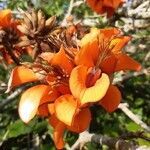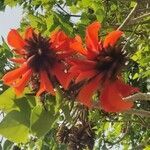Tree, 6-18 m high. Branches pale, rugose with prickles. Leaves 3-foliate, clustered near ends of twigs, glabrous with two small glands at base of petiolule. Leaflets: lateral ones similar in shape to terminal leaflet, usually acuminate, glabrous; leaves unarmed. Flowers orange-scarlet in colour, horizontal or ascending, gaping; flowers appearing before new leaves. Calyx with brown, campanulate tube, splitting laterally at anthesis. Petals: standard short and broad, strongly arcuate, exposing stamens; wings and keel comparatively long. Stamens monadelphous with filament tube slit right or left of vexillary stamen. Flowering time winter to early spring. Pod few seeded, constricted between seeds, subligneous, sickle-shaped, smooth. Seeds scarlet, with a black hilum.
Leaves scattered or clustered at ends of twigs, unarmed, glabrous; terminal leaflet 8–16 × 8–18 cm, broadly to very broadly ovate, often broader than long, acuminate; lateral leaflets 7.5–13 × 4.5–12(13.5) cm, ovate to elliptic, asymmetric; petiole 6–16 cm long, glabrous and unarmed when mature; rhachis 2.8–7.8 cm long; stipules minute, caducous.
Inflorescence a dense terminal pseudoraceme; appearing before the leaves; flowers spreading; peduncle 19–38 cm long, glabrous at maturity; rhachis 2–4.5 cm long; bracts membranous, ovate, caducous; pedicels 2–6 mm long; bracteoles minute, linear.
Corolla red, glabrous; standard 3.5–5.5 × 1.4–2.8 cm, obovate or elliptic, strongly reflexed; wings 0.9–2.4 × 0.3–1.1 cm, oblong; keel 0.8–2.1 × 0.4–1.4 cm, oblong, the petals fused along their lower margin.
Deciduous, prickly tree to 20 m. Leaves pinnately 3-foliolate, leaflets rhombic-deltoid. Flowers red to pink, standard recurved, calyx bilabiate at maturity.
Vexillary stamen free or joined only at the base, others fused into a sheath along two-thirds of their length.
Pod black, (10)12–20 cm long, irregularly constricted between the c. 4–6 seeds, glabrous when mature.
Seeds red, 6–8 × 4–6 × 2–3 mm; hilum black, 3–4 mm long, elliptic.
Tree (3.5)7–18 m tall, branches armed with prickles.
Ovary 1.4–2.7 cm long, narrowly cylindrical.
Calyx 1–1.9 cm long, 2-lipped, tomentose.
A tree.



